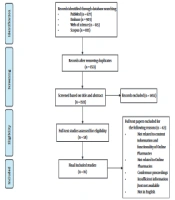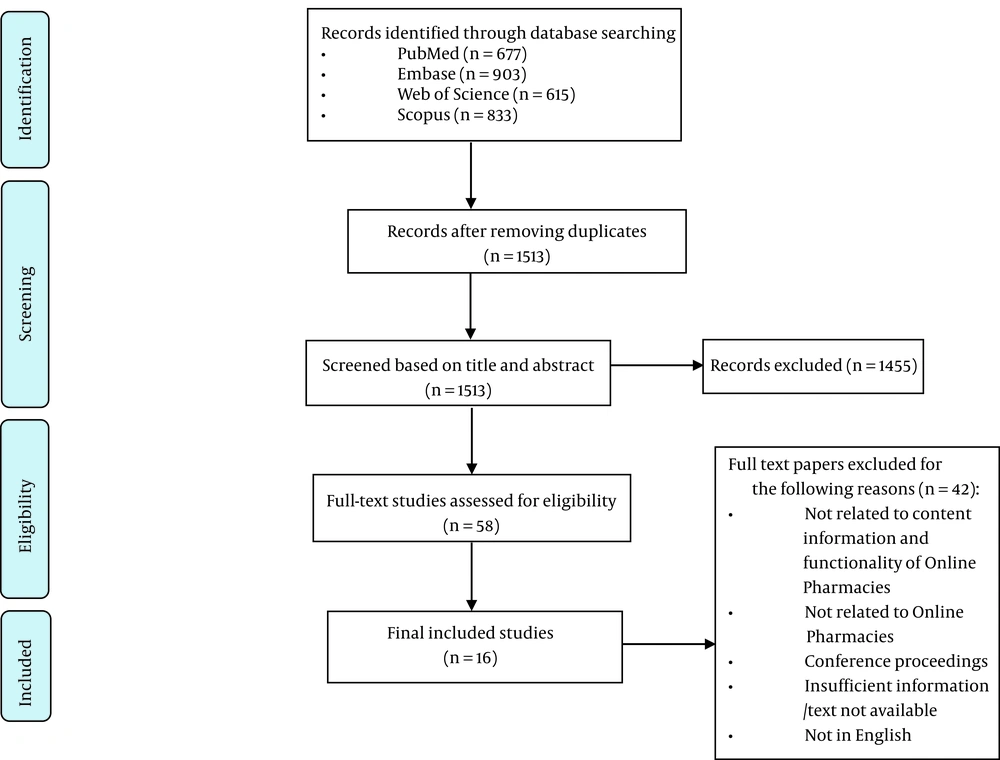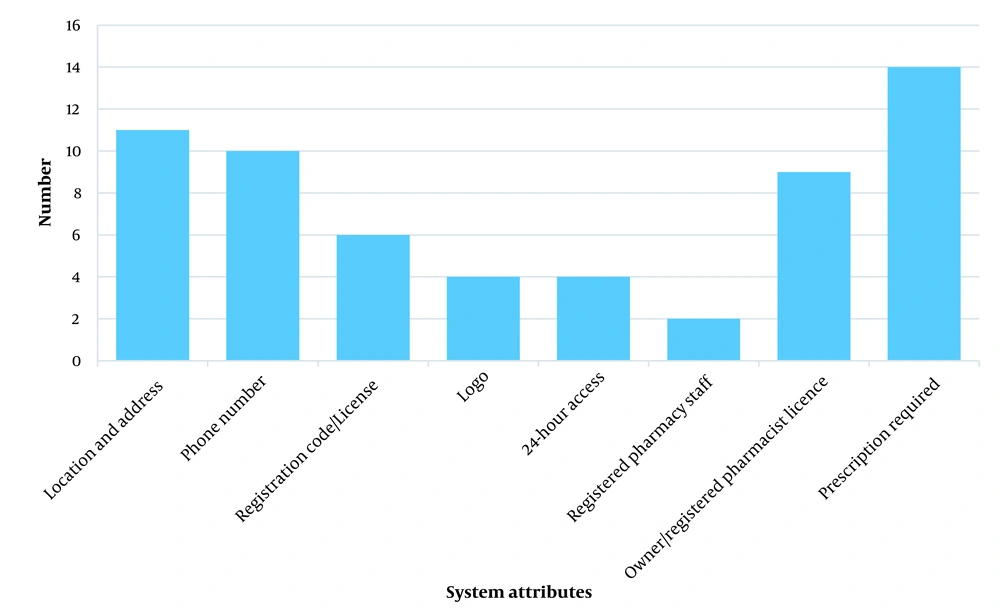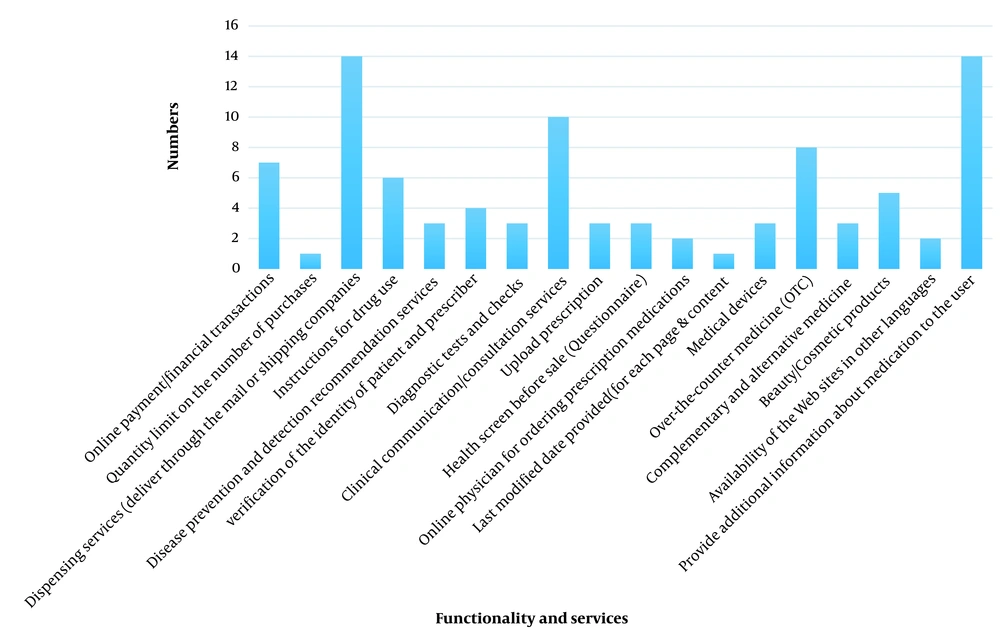1. Context
In recent decades, the increasing use of information and communication technologies has had a major effect on the healthcare delivery (1, 2). The number of internet users in the world increased significantly from 22.7% in 2008 to 59.7% in 2018 (3). In sub-Saharan Africa, estimates showed a five-year increase in Internet users from 35 to 50 percent (4). Over the time, advanced technology has caused changes in the pattern of shopping, including changes in purchases from pharmacies. This condition is a business opportunity for pharmacy entrepreneurs to grow business using online systems (5). New online sales methods and media are also used by pharmacies (6). Changes in consumer behavior advance in information technology, and the Internet is a critical factor in the emergence of virtual healthcare services, including online pharmacies. The annual increase in online purchases of consumer goods and services, which account for a significant proportion of drugs and health-related products, has been reported in the literature (7-9). Online pharmacies refer to online service providers and retailers of medicines, goods, and health-related services. These services offer considerable benefits including convenience and efficiency, competitive price, accessibility, privacy, and door-to-door delivery without geographical restrictions unlike traditional pharmacies (10). Local pharmacy websites are becoming more and more prevalently known as an online “healthcare center”, where patients can submit electronic prescriptions, order prescribed and over-the-counter medications, consult pharmacists about a chronic disease, get a prescription for a minor illness, and download the software. Check their health and order personal and home care products (11). A pharmacist’s role is to provide drugs sourced from an authorized distributor, verify the appropriateness of the prescription, and provide further support and guidance to the patient. Online pharmacies monitor or verify that the patient has a prescription or make evaluation themselves. They provide medicine from a reliable source and make recommendations if necessary (12).
There are many online pharmacies worldwide each with different content information, features, characteristics, facilities and properties. Including the content information, features, characteristics and facilities required by designers to design online pharmacy systems makes it possible to optimize system performance, collect standard data, recognize these systems, and facilitate their implementation. Prashanti et al. (13) discussed some advantages and disadvantages of online pharmacies compared with national pharmacies. In similar studies, the focus was more on design models and marketing topics. No systematic research collected the content information, features, characteristics and facilities required to design an online pharmacy system. To our knowledge, this is the first study to present the content information used, features, characteristics, and properties of online pharmacy systems.
2. Objectives
This study reviewed the literature to identify online pharmacies’ content information, features, characteristics and facilities. The present findings can be used as a model to design an online pharmacy system.
3. Data Sources
The review followed the Preferred Reporting Items for Systematic Reviews and Meta-analyses (PRISMA) (14) guidelines. The steps taken to conduct this review are summarized below:
3.1. Eligibility Criteria and Search Strategy
Initially, all articles describing the online pharmacy system were eligible and were considered for inclusion. Articles whose content information, capabilities and facilities were related to the provision of online pharmaceutical services. Books, animal studies, conference papers, commentaries, presentations, and letters to editorial were excluded. Only English-language papers were included.
3.2. Data Sources and Search Strategy
The four electronic databases PubMed, Scopus, Web of Science, and Embase were searched. A systematic review of papers was conducted on studies that report the content information, features, characteristics and facilities of online pharmacy. For this purpose, from 2005 to July 2021, a set of related keywords were found and selected. The keywords associated with online pharmacies were words meaning these systems and online pharmaceutical services provision. Box 1 shows the keywords used to identify the relevant papers. All these keywords were combined using the OR operator. Search strategy in all 4 databases is presented in Appendix 1.
| Keywords |
|---|
| 1- Virtual pharmacy |
| 2- Virtual pharmacies |
| 3- E-pharmacy |
| 4- E-pharmacy |
| 5- Online pharmacy |
| 6- Online pharmacies |
| 7- Internet pharmacy |
| 8- Internet pharmacies |
| 9- Online medication |
| 10- Electronic pharmacy |
| 11- Electronic pharmacies |
| 12- Online pharmaceutical services |
| 13- Online pharmaceutical service |
| 14- Remote pharmacy |
| 15- Tele-pharmacy |
| 16- Websites selling prescription drugs |
| 17- Online pharmacy practice |
| 18- Online pharmacy service |
| 19- Online pharmacy services |
| 20- Web-based pharmacy |
| 21- Web-based pharmacies |
| 22- Online drug distribution |
| 23- Online pharmaceutical care |
| 24- Online medication dispensing |
| 25- Internet pharmacy services |
Keywords Used in the Search Strategy
4. Study Selection
Initially, all studies were selected without considering the addition criteria to the study. At first, Mendeley identified duplicate papers imported from different databases. Then an Internet-based systematic review software platform (Rayyan QCRI) (15) was used to add search results electronically from databases to find and remove the remaining duplicates. The two authors (MHP, SN) independently reviewed the titles and abstracts found in the search process with eligibility criteria. Then, the full text of the articles was reviewed by the same two previous reviewers to select related articles. Any disagreement between the reviewers was resolved through meetings and discussion. If no agreement was made, a third reviewer (RKH) was consulted. In addition, the reference lists of relevant articles were evaluated for the relevant publications.
5. Data Extraction and Analysis
The data were extracted from papers selected by two reviewers (MHP, SN) independently using a Microsoft Excel data extraction form developed by (MHP). The third reviewer reviewed the extracted data to ensure that the data were accurate and complete. An email was also sent to the authors of two unavailable articles to access the text of those articles, but we did not receive any response. The data extracted from the articles were: Author’s name, year, type of study, objective, commercial/clinical, system platform, chain/community, System attributes, functionality and services (Table 1, Figure 1 and 2). These data elements and features were derived from the text, tables, figures, URLs, and screenshots available in the papers. content information, features, characteristics, facilities and properties related to the online pharmacy software system were available in the final extracted studies.
| Author’s Name | Year | Type of Study | Objective | Commercial | Clinical | System Platform | Chain/Community (Single) |
|---|---|---|---|---|---|---|---|
| Zwier (11) | 2017 | Qualitative study | Filling the gap in the combination of clinical and commercial services presented on the websites of licensed community pharmacies | Yes | Yes | Web based | Chain & community |
| Divekar and Gaud (16) | 2016 | Comparative paper | Describing the use of online pharmacies and comparing the rules prevalent in the USA and UK for the operations of online pharmacies | Yes | Web based | Chain & community | |
| Alwon et al. (12) | 2015 | Observational methodology | Determining the quality of approximately 100 online pharmacies and comparing this between regulated and unregulated sites | Yes | Web based | N/A | |
| Parikh et al. (17) | 2019 | Observational analytical study | Evaluating online pharmacy websites for compliance with regulatory criteria and comparing the prices of medicines sold by these pharmacies | Yes | Web based | N/A | |
| Yegenoglu et al. (18) | 2008 | Qualitative study | Finding all the existing web sites of Turkish community pharmacies and evaluating their “quality” in terms of Health on the Net (HON) Code of conduct principles | Yes | Web based | Community | |
| Su et al. (19) | 2011 | Qualitative study | Assessing the 32 qualified online pharmacies in China, and introducing the business model of 25 online pharmacies which are initiating an online business | Yes | Web based | Community | |
| Fittler et al. (20) | 2021 | Complex risk assessment method | Providing evidence for increased demand, online availability and consumer accessibility of Ivermectin, an anthelmintic agent, without substantiated indications in reference to SARS-CoV-2 | Yes | Web based | N/A | |
| Roshini et al. (21) | 2021 | Descriptive study | Describing the fundamental issues and challenges of online pharmacies | Web based | Chain & community | ||
| Fittler et al. (22) | 2013 | Evaluation study | Selecting, evaluating and following 136 Internet pharmacy websites to identify indicators of professional online pharmacy services and online medication safety. | Yes | Web based | N/A | |
| Gondim and Falcao (23) | 2007 | Descriptive study | Evaluating Brazilian online pharmacies to assess the validity and potential gaps in the information provided | Yes | Web based | N/A | |
| Mazer et al. (24) | 2012 | Review | Determining the frequency and characteristics of online pharmacy used by ED patients | Yes | Web based | N/A | |
| Kumaran et al. (25) | 2020 | Evaluation study | Describing desirable characteristics and regulations | Yes | Web based | N/A | |
| Gabay (26) | 2015 | Evaluation study | Evaluating verified Internet Pharmacy Practice Sites | Yes | Web based | N/A | |
| Shaikh et al. (27) | 2019 | Mini-review article | Expounding on the historical development of internet pharmacies, their rapid growth during recent times, their advantages, concerns and regulatory actions to keep them under control; containing advice to customers to avoid monetary and physical harm from illegal online pharmacies | Yes | Web based | N/A | |
| Abanmy (28) | 2017 | Evaluation study | Exploring the extent of use of online pharmacies in Saudi Arabia which will be useful for the scientific community and regulators | Yes | Web based | Community | |
| Jiang et al. (29) | 2020 | Cross-sectional survey | Employing the simulated client method to investigate the sale of antihypertensive drugs by online pharmacies across China | Yes | Web based | N/A |
Study Characteristics Included (n = 16)
6. Results
We first identified 3,028 records by searching the literature databases (Figure 1). Then, 1,515 duplicate papers deleted. The initial screening of titles and abstracts of the remaining 1,513 papers was done. In the next step, 1,455 papers were deleted, and 58 eligible papers were selected for a full-text review. Finally, 16 papers that remained, met our inclusion criteria and were used for a detailed analysis. The main characteristics of these papers are summarized in Table 1 and Figure 2.
Table 1 shows that out of 16 papers, 11 papers were published from 2015 onwards (11-13, 16, 18, 19, 24-28). Apart from one (20), 15 others addressed the issue only from a commercial perspective. None of the studies provided services on the application platform, but all were web-based. Three papers reviewed community (single) and chain pharmacies (11, 15, 20). Also three papers examined only community (single) pharmacies (17, 18, 27). The results are shown in Table 1.
Figure 2 shows the characteristics and attributes of online pharmacy systems. In 11 papers, the geographical location and address of the pharmacy were mentioned on the website (11, 12, 15-19, 21, 24, 25, 30). The pharmacy contact number was mentioned in 10 papers (15-19, 21-25). Out of 17 papers, only six mentioned the registration code or activity license (12, 15-17, 19, 20). The logo was another parameter addressed in only four paper (15, 16, 19, 21). Out of 16 papers, four provided services 24 hours a day (12, 16, 18, 27). The personnel profile was another feature uploaded on the website in only two papers (12, 15).
In 14 papers, prescriptions were required to provide pharmaceutical services (11, 12, 15, 16, 18, 26, 28).
Figure 3 lists the facilities, operations, and services reported in the reviewed papers. Limitation on the number of orders for pharmaceutical items by the customer was a feature reported in only one paper (16). Distribution and delivery services were another feature introduced in 14 papers except for two (11, 12, 15, 16, 18-27). The ability of the online physician to order prescription drugs was also reported in two papers (11, 15). Three also provided services in the field of medical equipment (11, 12, 18). The ability to provide additional information about drugs was also a feature mentioned in fourteen papers (11, 12, 27, 28).
7. Discussion
The present study identified and reviewed the content information, features, characteristics and facilities of online pharmacy systems. This study showed a high variety in the use of features, services and capabilities of online pharmacy systems.
Most online pharmacy systems became popular after 2015. Most of them were web-based and for business purposes. Depending on the rules and regulations of each country, some features of these systems were mandatory and some optional. For example, prescriptions were required for pharmaceutical items in some and optional in others. Some pharmacies distributed and sent drugs via postal companies to customers, but others did not.
Out of 16 papers, only 1 indicated a limit on the number of orders (16). It shows that the commercial dimension has received more attention than the clinical dimension. A lack of restrictions on ordering some drugs can create opportunities for disruptors in the drug market.
In 14 of the 16 the cases analyzed, the parameters of sending services and pharmaceutical items through postal companies and receiving additional information about drugs were found to be the most common parameters. It points to the customers’ desire to receive services and purchase pharmaceutical items remotely. The online pharmacy system can also be used as a reference for people to receive medical information.
Easy access to services can be the main reason for choosing an online pharmacy (29). In this study, all the papers submitted were web-based and there were no application-based papers, which could affect the easy access to services. In some, the physical address of the pharmacy, contact number, activity license details, and pharmacist and staff details were not mentioned. In contrast, according to the existing rules of most countries, these details should be available in the online pharmacy system (31). This could show that such online pharmacies are illegal (30). Illegal pharmacies can pose direct and indirect risks to patients and shoppers (10). It shows inconsistency in the use and compliance with international standards and rules in online pharmacies. In some countries, regulatory agencies established some rules and regulations to further monitor the delivery of pharmaceutical services based on online platforms, which must be used as required (32). Some online pharmaceutical systems are licensed only to provide services within a country, but some are available worldwide in most countries. These internal rules may not be helpful, but may restrict global free access to certain pharmaceutical services. Thus, domestic rules may not meet all the needs of such systems, and there is a need to set rules and standards on a global scale (33, 34).
The papers reported in this study were examined without considering the national rules and regulations. The present findings can be used for designers of such systems, who choose the aforementioned items in future designs. The next step could be to study how to provide technical solutions to facilitate communication and data exchange between such systems.
7.1. Limitation and Future Research
In the present study, there were 3 limitations. At first, two papers could not be accessed despite further search and sending emails to authors. Due to the limited number, their absence had no effect on the results of this study. Secondly, this study covered papers published until July 2021. Therefore, no subsequent study was reported in this study. Future studies may include gray literature.
8. Conclusions
This study showed that online pharmacy systems differ in content information, features, characteristics, facilities and properties. Some features were mentioned in some studies but not in others. Depending on some circumstances, some parameters may or may not be used in an online pharmacy system. The design process will be easier for designers if international standards and rules are developed in the design of online pharmacy systems which ultimately makes it easier to use and share data.



